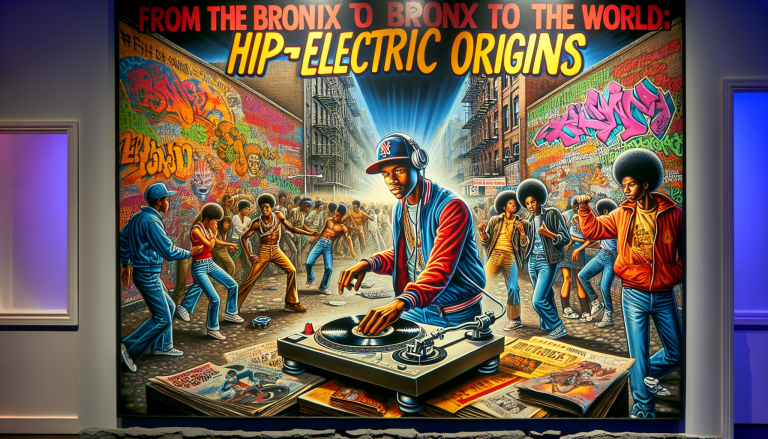The Pulse of the Streets: A Dive Into Hip-Hop’s Electrifying Odyssey

Picture this: the summer of 1973, The Bronx, New York City, a melting pot of cultures and a crucible of urban expression. It’s here, amid the concrete jungle and the rhythmic bustle of American music evolution, that hip-hop first exploded onto the scene like a sonic supernova. From the boom-bap beats echoing off row houses to the graffiti-splattered walls that scream identity, hip-hop was born as a raw, unapologetic voice for marginalized communities. This isn’t just music; it’s a cultural revolution packaged in 4/4 measures, a movement that redefined artistry and challenged the status quo.
Hip-hop’s historical context is inextricably tied to its roots in the socio-economic hardships of 1970s America. As urban decay and disenfranchisement gripped neighborhoods, especially in New York, hip-hop emerged as a creative outlet and a powerful form of storytelling. DJ Kool Herc, often hailed as the genre’s godfather, ingeniously manipulated breakbeats at block parties, spinning the instrumental “breaks” of funk and soul records to keep dancers moving. This technique birthed the foundation of hip-hop’s sound and culture. MCs (or rappers) soon entered the party, adding rhymes that echoed the realities, hopes, and frustrations of their communities.
A Genre That Defies Definition: The Essence of Hip-Hop
Hip-hop is a genre that transcends simple musical classification. It is a rich tapestry woven from four elemental pillars: MCing (rapping), DJing, breakdancing, and graffiti art. While each pillar has its own flair, together they create a holistic cultural phenomenon. The music itself is characterized by rhythmic vocal delivery over a beat, often sampled from funk, soul, or jazz records, layered with intricate drum machine patterns or live instrumentation. The lyrical content swings from playful boasts to potent social commentary, blending street wisdom with poetic expression.
This genre’s tempo is flexible yet infectious—sometimes aggressive and fast-paced, other times smooth and contemplative. Beat-makers constantly innovate, using drum machines like the legendary Roland TR-808 or samplers like the MPC to craft iconic rhythms. Hip-hop collaborations meld voices and styles, creating a mosaic of sound that carries endless diversity—from the hardened grit of East Coast rap to the laid-back groove of West Coast flows, and beyond.
Icons Who Shaped the Soundtrack of Generations
No journey through hip-hop is complete without tipping the hat to its key architects. DJ Kool Herc’s pioneering breaks set the stage, but it’s the mavericks who followed that turned hip-hop into a global powerhouse. Grandmaster Flash took DJing to technical heights with his innovative mixing and scratching, while Afrika Bambaataa expanded the genre’s sonic and cultural horizons, fusing hip-hop with electronic elements that foreshadowed dance music’s evolution.
Fast forward, and the genre exploded with figures who now read like legends: Run-D.M.C. smashed barriers with rock crossover hits like “Walk This Way,” blending genres and smashing stereotypes. Public Enemy turned hip-hop into a weapon of political resistance, with tracks like “Fight the Power” stirring listeners to action. Tupac Shakur and The Notorious B.I.G. transformed rap into poetic chronicles of street life, love, and loss, their profound lyrics resonating far beyond their untimely deaths.
In the modern era, artists like Kendrick Lamar and J. Cole carry the torch, blending storytelling prowess with sonic innovation, proving that hip-hop remains a vital pulsar in American music. Meanwhile, artists such as Missy Elliott and Missy’s contemporaries brought an unapologetic female energy that propelled the genre in exciting new directions.
Tracks and Albums That Echoed Through Time
Landmark albums act as cultural time capsules, each marking significant chapters in hip-hop’s saga. Grandmaster Flash and the Furious Five’s “The Message” was a groundbreaking single unveiling urban struggles with stark realism, a blueprint for socially conscious rap. Run-D.M.C.’s self-titled debut album brought street authenticity into mainstream consciousness with unmatched swagger.
The Notorious B.I.G.’s “Ready to Die” remains an unparalleled narrative masterpiece, while Nas’s “Illmatic” epitomizes lyrical excellence and production wizardry. In more recent years, Kendrick Lamar’s “To Pimp a Butterfly” shattered expectations with its blend of jazz, funk, and conscious lyricism, redefining the boundaries of what hip-hop could express.
These sonic landmarks didn’t just energize dance floors—they challenged listeners intellectually and emotionally, proving that hip-hop can be both deeply personal and universally relatable.
Hip-Hop’s Lasting Footprint on Culture and Beyond
Hip-hop’s influence is as enduring as it is omnipresent. What started as a localized cultural expression has burgeoned into a global phenomenon that channels the heartbeat of not just American music, but worldwide artistic and social conversations. The genre reshaped fashion (hello, sneaker culture and oversized jerseys), language (slang that’s woven into everyday vernacular), and even politics, with artists emerging as activists and changemakers.
Its blending with EDM and dance music illustrates hip-hop’s flexible DNA. Producers seamlessly integrate rap verses into vibrant dance beats, creating genre-defying tracks that dominate festivals and club scenes. This nutrient-rich cross-pollination underscores the genre’s dynamic nature—constantly evolving, never stagnant.
“I see hip-hop as a modern-day blues, a way for people to speak their truth,” says renowned hip-hop journalist and author Jeff Chang. He nails it. Hip-hop is both mirror and megaphone—reflecting societal realities while giving voice to those often overlooked.
From kinked turntables to arena stadiums, hip-hop reigns supreme, a testament to creativity born from adversity and the transformative power of rhythm and rhyme. Whether you’re a seasoned aficionado or a curious newcomer, diving into hip-hop means entering a world alive with history, heart, and unapologetic soul. The beat goes on—and it’s one hell of a journey.